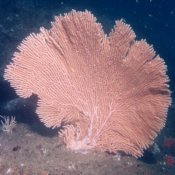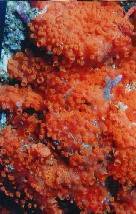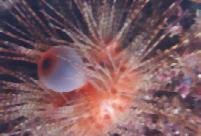Home >>
Oaxaca >>
Scuba Diving
 Scuba Diving Scuba Diving
on the Oaxacan Coast
SCUBA: self-contained underwater breathing apparatus
|
|
Periodic strong wave action
on the Pacific can affect all water sports activities. This phenomena is known as Rebalses.
The rugged terrain continues into the sea with rocky outcroppings jutting from the sandy bottom. The rocks support coral growth but not the large reefs that you find in places like Cozumel. Visibility is typically 50' but varies with wave action, wet season runoff, and by location. Sea life is abundant.


"Sea fan" coral; Gorgonia
| |
Hurricane Divers (958) 587-1107 is located at the corner of Benito Juarez and Chahué in Huatulco, Oaxaca. They offer scuba diving and snorkeling excursions, packages, instruction. Also equipment sales and repair. Carlos Ramos charlie_diver@hotmail.com has now joined Hurricane Divers. See scuba diving article and photos by Carlos.
There is a dive shop in Puerto Angel, Oaxaca, called Azul Profundo (958) 584-3109, located on Playa Panteón.
In Puerto Escondido, there is Puerto Dive Center located on the Adoquín. (954) 582-7517. info@puertodivecenter.com. See photos of underwater Puerto Escondido from Scott Sousa.
| |

Small coral colony
|
Diving in Huatulco
So what's the diving like? What we have is a myriad of high-profile rock reefs, usually well-decorated with hard and soft corals, gorgonians, and fans. Unlike Puerto Angel, most of the decorations here are intact. In Puerto Angel, the poor hookah fisherman strip a lot of soft coral as well as giant starfish to dry and sell to the brujos (medicine men) from the Valley of Mexico. The brujos powder the fauna to make folk medicines. Here in Huatulco, the fisherman quickly learn that tourists pay more to see the life than brujos pay to consume it. Our fish life is miraculous. This coast serves as a nursery for most of

The Erizo Diadema or Crown of Neptune sea urchin is brown and white, with the shape of a star drawn in its body in neon blue spots. -photo submitted by Carlos Ramos
| |
|
the tropical waters in the Eastern Pacific. On a typical dive, you'll see four or five different species of puffer. King Angels are plentiful and the Cortez Angel is present. Jewel fish and goat fish abound. On night dives, I have seen nine different species of moray eel, including a snake eel no bigger around than your little finger but up to three meters long! For the shell collectors, there are several species of conch, including the spiny tiger conch, as well as several cone shells and turbans. Most of the really big stuff stays at the outer limits of sport diving, but we are often surprised by pelagics coming in for a visit.
Now this is the open Pacific. You really can't expect a regular diet of Caribbean-clear water. The Middle Trench is only a few miles offshore, so we have a goodly amount of upwelling, bringing nutrients up for the filter-feeders. While we do have days of 30 meter/hundred foot visibility, twenty meters is closer to the norm. Even during the rainy season, twelve to fifteen meters of visibility is available. It's often a matter of how far you want to go from the hotel. Some areas will have more blue-faced damsels than dusky damsels; you'll find beaugregories at nearly any site. See Fish of the Oaxacan Coast.

Fernando Valenzuela, Domingo, and John Williams scuba diving in Puerto Angel.
| Top of page |
Main index |
Search |
What's new |
The Pacific Coast of Mexico
 www.tomzap.com
www.tomzap.com
 Tom Penick:
tom@tomzap.com
Tom Penick:
tom@tomzap.com




